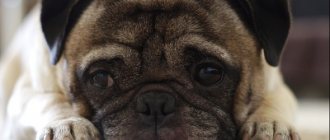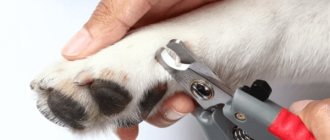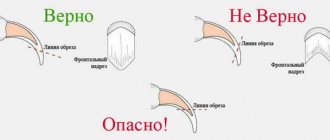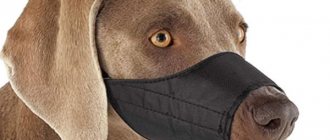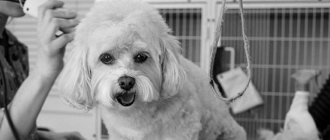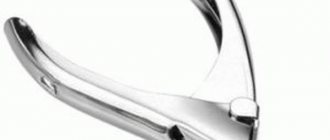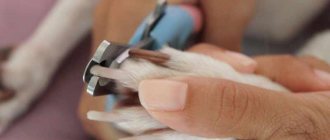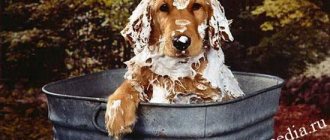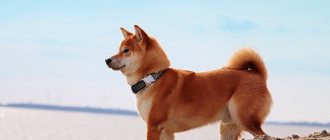Save the article:
Caring for a pet dog is a constant thing and necessary not only for maintaining a pleasant appearance of the animal. The beauty of the breed is maintained by full grooming. Many people think that simply washing and cutting their pet’s fur is enough. This is not enough: you need to take care of your paws and learn how to cut your dog’s nails. Why this is needed and how to do it correctly at home is described below.
Hygiene procedures
All pets need proper care. This will improve your pet's health and extend its life.
Procedures necessary for a dog include:
- Bathing allows you to keep the animal's fur clean;
- Combing. Promotes smooth and silky fur;
- Teeth cleaning. Dogs are susceptible to dental disease, so it is important to brush your dog's teeth at least once every two days;
- Nail trimming. Necessary to prevent nails from growing into pillows.
It is best to entrust the cutting of dog nails to a professional: a Veterinarian or a groomer.
But, if it is not possible to contact a specialist, then you can cut your nails yourself, at home. The process of cutting nails is not complicated, although it does require certain knowledge and preparation.
Benefits and importance of the procedure
During a short walk, the dog's claws do not wear down so much that they do not grow in and cause pain to the animal. Long legs can break, causing pain, and they also interfere with the dog's walking.
- Nails that are too long can cause joint deformities.
- The rudimentary claw curls and digs into the paw, causing pain.
- While playing with the owner or children, the dog can hurt painfully with its long claws.
- The dog may involuntarily scratch furniture or things.
- Therefore, all pet dogs need to have their nails trimmed.
An exception to this rule may be dogs that live or spend most of their time outdoors. That is, animals that have the ability to grind their claws on the hard surface of concrete or asphalt.
What to choose – trim or file your nails
Another option for treating claws is an electric file . The file used to process a dog's claw is no different from the one used to process human nails.
An electric file is a device with replaceable heads that, rotating quickly, grind down the claw. Compared to a nail clipper, a file is much less traumatic, but processing takes longer than with scissors.
In any case, even when using a nail clipper, it is necessary to file the sharp edge of a freshly cut claw to avoid its delamination.
Correct haircut
The structure of a dog's claw is such that, in addition to the keratinized part, there is a large blood vessel inside the nail. The uniqueness of the vessel is that it grows with the nail. The longer the nails are not cut, the closer the vessel is to the tip of the nail.
You can see the vessel in the dog’s light-colored claws, but in the black claws it is not visible at all. How to cut a dog's nails correctly?
- First, take your pet's paw in your hand so that it is comfortable for both. Move your finger away, but do not squeeze it.
- Trim the claw at an angle of forty-five degrees, from top to bottom to the beginning of the vessel. That is, you need to cut a few millimeters below the vessel.
- Black claws must be cut a millimeter at a time.
Where should you cut your dog's nails? To the place where the tip of the nail stopped peeling, reaching the dark core of the nail.
- When cutting a nail, carefully inspect the cut; if the core of the nail is white, then you can still cut it.
- Trim each claw in this manner, not forgetting the fifth toe.
- After cutting, you can treat the claws with a file or grinder.
- It is better to start cutting the haircut from the front paws.
- During the grooming process, you can reward your dog with some kind of treat. This video shows how to properly trim a dog's nails.
First aid for injuries
Despite full compliance with the rules and compliance with the operating algorithm, even an experienced owner can make a mistake. This can be caused by various circumstances: a sharp sound outside the window, a dull nail clipper, or excessive nervousness of the pet. Don't get upset - it's important to remain calm, apologize to the dog and treat the wound.
Pulp cut
Trimming too short greatly increases the risk of damaging blood vessels. This causes severe pain and excessive bleeding. The main task of the owner in case of pulp injury is to urgently stop the bleeding. In addition, it is necessary to calm your four-legged friend - his reaction will be panic and a desire to run away.
The owner should try to distract the animal, switch its attention to something else - perhaps to a toy or a pre-prepared treat. There is no point in screaming at this moment, as the dog is already scared and in pain. Next you need to treat the wound with hydrogen peroxide. It is not recommended to use alcohol-based solutions - they will only increase the pain and cause a burning sensation.
Antiseptic powder has a good effect. Veterinarians advise having this drug in your pet first aid kit. It is used to treat open wounds and abrasions and copes well with injuries caused during trimming of the nail plate.
Claw detonation
A similar nuisance arises in the case of nervous and uncertain actions of the dog breeder. The dangerous combination of slow compression of the nail cutter along with an unexpected and sharp jerk of the limb during shortening leads to a poor result. Damage to the skin and soft tissues is accompanied by severe pain and fear, and not only from the dog - the owner also experiences nervous shock. However, you should gather your strength and provide first aid to the victim:
- Try to keep the animal in place. Don't shout, but be assertive and speak confidently.
- Next, you need to bandage the injured limb near the metatarsus with a tourniquet or bandage. It is advisable to lift the paw up to stop the bleeding.
- Cold is applied to the damaged surface. You can use an ice pack or frozen food for this.
- Open wounds must be treated with lidocaine or novocaine.
- Sometimes the damage is very severe, so the tear must be stitched. Only a veterinarian can do this.
When transporting an animal to a veterinary clinic, cold should be applied to the damaged area, but at the same time avoid frostbite of the limb.
Preparing the animal for the procedure
You need to accustom your pet to trimming its nails from childhood. So, over time, the animal gets used to the procedure and does not panic at the sight of the tools. If the dog is not familiar with the grooming process and is afraid to cut its nails, it is necessary to properly prepare the pet.
- To do this, a couple of days before the haircut, you need to establish tactile contact: touch the dog’s paws and pads so that it gets used to it, squat down to be on the same level with the pet.
- The best moment for a haircut is when the dog is fed and calm. Before the procedure, you need to walk the dog. Before you start, you need to talk to the dog, pet it, and psychologically adjust it.
Required Tools
For cutting, you will need a special tool, since ordinary scissors or clippers can cause harm by cutting the nail poorly. Therefore, you need to buy nail clippers from a veterinary pharmacy.
Tools for trimming claws are:
- Special scissors. They are made of durable metal construction;
- Wire cutters. Special for trimming claws;
- Guillotines that are best suited for large dogs.
All instruments must be made of stainless steel, the handles must be comfortable and rubberized so that the instrument does not slip in the hand during the procedure. The tool must be perfectly sharpened, capable of cutting a claw of any thickness in one go.
Hair clipper
Instead of the usual tool, you can use a special nail clipper for your dog. The disadvantage of the machine is that it is noisy, so it can scare the animal.
The process of filing sawdust with a machine will take longer; the pet may not be able to sit in one place for a long time. In addition, there is a danger of injuring the pads.
For variety, you can buy a regular nail clipper and a clipper to compare and choose which is better. Nail clippers are professional and compact, battery operated.
Choosing a nail clipper
Despite the extensive range of products, there are only 3 main types of “scissors”: sickle, guillotine and nail files.
1. Sickle-shaped nail clippers are the most familiar and convenient for us. The curved blade allows you to quickly and painlessly remove excess parts.
2. Guillotines have a ring into which you need to insert a claw. This device has a number of disadvantages. Firstly, it is difficult to sharpen. Usually, if the blades become damaged, you have to get rid of the guillotine. Secondly, in the process, the nail cutter literally breaks the tissue, which sometimes causes longitudinal splits.
3. There are 2 types of nail files: automatic and regular. Using a grinder is a real pleasure, but it is not cheap. In addition, some dogs are afraid of vibration and noise. An ordinary rough file for artificial nails will help if the pet categorically does not accept nail clippers. Animals usually agree to a compromise.
Cutting nails at home
The instrument should be disinfected before the procedure. It's a good idea if the dog has the opportunity to sniff the clipping tool. The dog's nails should be disinfected to avoid infection if the animal is accidentally injured.
For the same purposes, a hemostatic agent should be on hand. First you need to determine the length of the cut; you should not rush. It is better to cut off the claw little by little so as not to damage the vessel.
By cutting off only the curved part of the nail, it is impossible to damage the vessel. If the dog begins to get nervous during the procedure, it is better to let it go and postpone the procedure until the next day. How often should you cut your dog's nails? Your pet's nails should be cut at least once every three to four weeks.
How often should a dog's nails be trimmed?
Veterinarians do not give a clear answer to this question. The frequency of the procedure directly depends on the dog’s lifestyle, as well as on the surface on which it moves.
If your four-legged pet lives in comfortable apartment conditions, uses a litter tray and moves only on parquet or laminate flooring, then it is necessary to trim its nails quite often. And if the dog leads an active lifestyle, spends a lot of time in the yard, walks and accompanies its owner everywhere, then the procedure should be performed much less frequently. After all, the claws wear down naturally and only sometimes does it become necessary to make corrections.
Veterinarians remind that there are blood vessels inside the claw. The longer the claw grows, the longer the blood vessel will be. Therefore, it is so important for the owner to prevent it from growing to excessive length. In this case, it will no longer be possible to adjust the length without the risk of damaging the vessel. This is directly associated with pain and discomfort for the pet.
Useful tips
- It is more convenient to cut the nails on the hind legs when the dog is lying down.
- If the thick fur makes it impossible to see the nail, the hair should be cut off.
- If the dog does not sit quietly, then someone needs to hold the dog. In this case, the pet will need to be carefully grabbed by the neck so that the head is fixed.
- Under no circumstances should you raise your voice while grooming, so as not to worry the animal.
- While in a clinic where your pet is undergoing any procedure under anesthesia, you can ask the veterinarian to cut his nails at the same time. Many specialists do this without requiring, in this case, payment for a haircut.
- If an animal was once injured during a home grooming, then next time you should immediately seek help from a specialist.
- Do not refuse sedatives if they are offered by specialists for the procedure. It happens that professionals also injure an animal.
If bleeding lasts for more than half an hour after an unsuccessful haircut, you must immediately contact the clinic.
How is the service provided in the salon and how much does it cost on average?
The standard cost of a hygiene procedure is in the range of 300-1500 rubles. The final price depends on the pet’s behavior and the need to use sedatives.
Trimming in the salon
When contacting the salon, the groomer establishes contact with the pet and tries to carry out the event without the use of sedatives. The process takes a little time - from 20 to 30 minutes. In case of severe aggression, the dog is given a drug, and after its effect begins, the overgrown plates are shortened.
Important! For help, you need to contact professional salons, not dubious offices.
